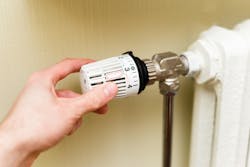Having been in this business for more than 30 years, I have seen some things that if you’d told me 30 years ago that I’d be seeing them today, I’d probably have laughed myself to sleep. Computers on boilers? You must be kidding! And now, here we are today, with more computing power onboard even the lowliest of boilers than there was on the spacecrafts that circled the moon many years ago. And don’t get me wrong, I am all for increases in system and employee efficiencies, but every once in a while it pays to step back and look at all the offerings.
Non electric TRVs
I remember well my first experience in applying non electric thermostatic controls to a radiant floor heating system. When I’d called for my rough inspection, I met the inspector on site, as I always did when I could afford the time, and he marveled at the fact that we didn’t have to run wires to control the temperature within the room. He was actually quite ticked at the thought of a fitter being able to take work from another tradesman (electrician). I reminded him that we really couldn’t survive without the other fellow tradespeople.
I had previously been exposed to the concept of Thermostatic Radiator Valves (TRVs) on panel radiators, which made all the sense in the world to me, but I hadn’t seen the extrapolated version that we incorporated into this radiant floor heating project. This particular system was actually piped into a series circuit, with the return lines coming from the manifold serving a given zone. It was a European manufactured device that had a recessed box in which the sensing element sat and the valve box held the actual brass actuator that closed off the flow of water circulating to the zone. About the only real negative at that point in time was that due to its nature (non-electric) it couldn’t easily incorporate a setback temperature for those who wanted or felt they needed a setback capability.
While we are here, for the benefit of those of you who are new to this trade, high mass radiant systems are not conducive to deep setbacks or fast recovery. This is why we stress zoning flexibility. If you like your sleeping areas cool, keep them turned down. Don’t try to send them on a roller coaster ride of daily temperature swings. No one, other than the utility provider, will win that battle. More on that subject at a later date.
Times, they are a changing. They now have battery powered TRVs that will work in low mass settings (steel panel radiators or low mass radiant floors and/or ceilings for, example) to allow the end users the ability to do setbacks and set ups. I’d still recommend the use of caution in deploying these items, because the TRV doesn’t speak the same language as the boiler control does, and neither knows the other even exists; not to mention we are dealing with the mean radiant temperature, not air temperature.
The really neat thing about TRVs is that their control ability is proportional to the connected load. In other words, as the room cools down just a little bit, the TRV “sees” this drop in room temperature and opens its valve just a little bit, allowing a small flow of heated fluid to the affected zone. As the room approaches set point, the TRV chokes the flow down, so that supply actually matches demand to 99 percent. In other words, unless there is a significant increase in room temperature due to internal gains from solar gains or body heat, the valve never closes completely. It’s the ideal situation of supply matching demand and hitting thermal equilibrium.
This requires the use of a constant run differential pressure control circulator, but with all of the variable speed circulators on the market today, that is the least of your problems.
If someone inadvertently leaves a door or window open during extremely cold conditions, the TRV will also see this and will open its needle valve completely to allow maximum flow to the heat emitter. If a long term deep setback is desired, or required, it typically requires that a solid state sensor be placed in the worst case heat loss scenario zone, and that becomes the “reference” zone.
The really neat thing about TRVs is that their control ability is proportional to the connected load.
This reference zone typically doesn’t have a TRV connected to its load. Boiler temperature modulation is based on this worst case scenario zone. All other TRVs will be set to that room’s “comfort” setting, another interesting feature of these European devices. There is no “68 to 72” degree comfort zone setting like there is on a typical low voltage thermostat. There are numbers from 0 to 5, with 3.5 being the rough equivalent of 70°F, give or take a point. It does, however, require a complete but quick re-education of the consumer who is used to seeing a degree F setting, not numbers between 0 and 5.
Tune in next month as we continue to look at these very simple marvels of room temperature control. And please, join the Radiant Professionals Alliance, a very worthwhile organization that keeps you, the contractors and wholesalers, in mind.
Until then, happy hydronicing!
Mark Eatherton material on this website is protected by Copyright 2016. Any reuse of this material (print or electronic) must first have the expressed written permission of Mark Eatherton and CONTRACTOR Magazine. Please contact via email at: [email protected].
About the Author
Mark Eatherton
Mark Eatherton material on this website is protected by Copyright 2017. Any reuse of this material (print or electronic) must first have the expressed written permission of Mark Eatherton and CONTRACTOR Magazine.
